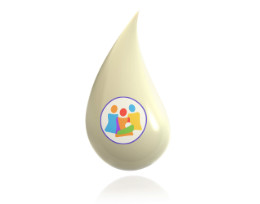Managing Plugged Ducts
What is a plugged duct, and why do they occur?
A ‘plugged duct’ is a region of the breast where inflammation has occurred, blocking flow of the milk thru the ducts. Milk ducts are super tiny, so it is not caused by just one duct having a blockage of dried or congealed milk. It is a whole region of slowed milk flow due to swelling around the ducts. When the milk cannot move through the ducts, and is static for a period of time, the fat globules can stick to each other, causing ‘plugs’.
A person with a plugged duct notices a tender region of the breast that has not drained after breastfeeding or pumping, along with discomfort when directly feeding or pumping. Plugged ducts typically last for no more than 48 hours, and often resolve sooner than that. ANY MASS THAT LASTS LONGER THAN 48-72 HOURS CAN NO LONGER BE CONSIDERED A PLUGGED DUCT. IT IS IMPORTANT TO BE SEEN BY A PHYSICIAN FOR FURTHER EVALUATION.
An uncomplicated plugged duct is not associated with a fever or breast redness. If fever and breast redness occur, the area may be developing mastitis, so it is recommended to be seen by a physician.
Why do plugged ducts happen?
Plugged ducts may occur for a variety of reasons. Any time milk is being produced but not being removed on a timely basis, or not removed well, congestion of milk in areas of the breast may occur. This can lead to swelling around the ducts, making it difficult to drain milk through the ducts. As the swelling resolves, the milk can start flowing again. Another reason for plugged ducts is a change in the bacterial balance in the milk-making tissue and milk. Over growth of bacteria results in the presence of more bacterial DNA, which is sticky, along with narrowing of ducts due to inflammation. Here are some typical situations that create the conditions for recurrent plugs:
- Overproduction of milk. Overproduction can cause areas of milk pooling, with swelling and congestion around the milk ducts.
- Irregular breastfeeding or pumping patterns. Every lactating person has a tolerance for how often they need to remove milk (breastfeed or pump) to prevent plugs. For some people it is 3 times a day and for others it is every 2 hours. Staying on a schedule can help to prevent plugs.
- Taking herbs or medications that increase milk production, especially in situations when there is inadequate or infrequent direct feeding or pumping.
- Relying on a breast pump. Pumping is often less effective at milk removal throughout the breast as compared to infant feeding at the breast or chest.
- Using a nipple shield, that makes it difficult for the infant to remove milk from all areas of the breast.
- Pump problems. If the pump vacuum is too low, or the cycle rate of the pump is too high, milk removal may not be as effective. Milk removal may also be ineffective if the flange size is too large or too small.
- Low grade (subacute) mastitis, due to bacterial imbalance in the breast.
- Dietary factors. Very occasionally people find that eating a diet high in animal fats (whole milk, cheese, ice cream, red meat) increases the frequency of plugged ducts. This may have to do with how animal fats change the fatty acid make up of the triglyceride molecules in the milk fat.
How can I treat and prevent plugged ducts?
- If you have a plug, or are experiencing recurrent plugs, remove milk at the rate that has been normal for you when you were not experiencing plugged ducts. Do not pump or breastfeed more often since that may increase milk production in the region where there is already congestion/swelling.
- Give it time. The plugged area became congested, likely due to over-filling. Be patient as the swelling resolves. Avoid compression and/or deep massage, which will worsen the swelling and increase the risk of an infection such as mastitis or abscess.
- Gentle lymphatic massage may help to reduce the swelling in the plugged region. See the IABLE Lymphatic Massage Video.
- Get rest, and take care of yourself with a well-balanced diet and adequate hydration.
- Apply warm or cool compresses for relief of symptoms based on what makes you feel better.
- Check with your physician or provider about whether you can take acetaminophen or ibuprofen, and ask about the dose that is safe for you.
- Lecithin can often help to treat and prevent plugs. Lecithin capsules are typically 1200mg and may be soy or sunflower based. The dose is typically 2-3 capsules twice a day when plugged ducts occur, and 1-2 capsules twice a day to prevent plugged ducts.
- If possible, directly feed your infant at your breast or chest, rather than relying on your pump.
- If you are producing more milk than what your infant(s) need, see a lactation consultant or breastfeeding medicine specialist for counseling on how to safely reduce your milk production.
- See your physician if the plugged duct has not resolved by 48-72 hours, or you develop breast redness with increased pain and fever, which can indicate infection. A plugged duct that lasts for more than 48-72 hours needs further evaluation to be sure it is not something more serious.
What should I NOT do when I have a plug?
The following commonly-given advice may worsen plugging and should be avoided:
- Avoid aggressive massage. Aggressive massage can damage the ducts and breast tissue, worsen swelling and inflammation, and increases the risk for having more plugged ducts or mastitis.
- Avoid pumping on higher settings. Pumping with higher suction does not improve milk extraction and can cause pain and trauma to your nipple, areola, and breast. It is more important to remove milk on your normal, regular schedule.
- Avoid unroofing blebs. If you have a stubborn bleb that does not improve with regularly feeding/pumping, then speak with lactation consultant or a breastfeeding medicine physician or provider to help with the bleb.
When should I call my physician or other provider if I am concerned about mastitis (breast redness and fever)?
- Symptoms are mild with low grade fever, redness to the breast region and pain, and do not improve within 12-24 hours.
- Fever higher than 100.4°F (38°C), and/or feeling faint, dizzy, weak, heart racing, vomiting, headache.
- Worsening breast redness/pain, or red streaks form on your breast.
- Blood or pus in your milk.
- Cracked sore nipples.


